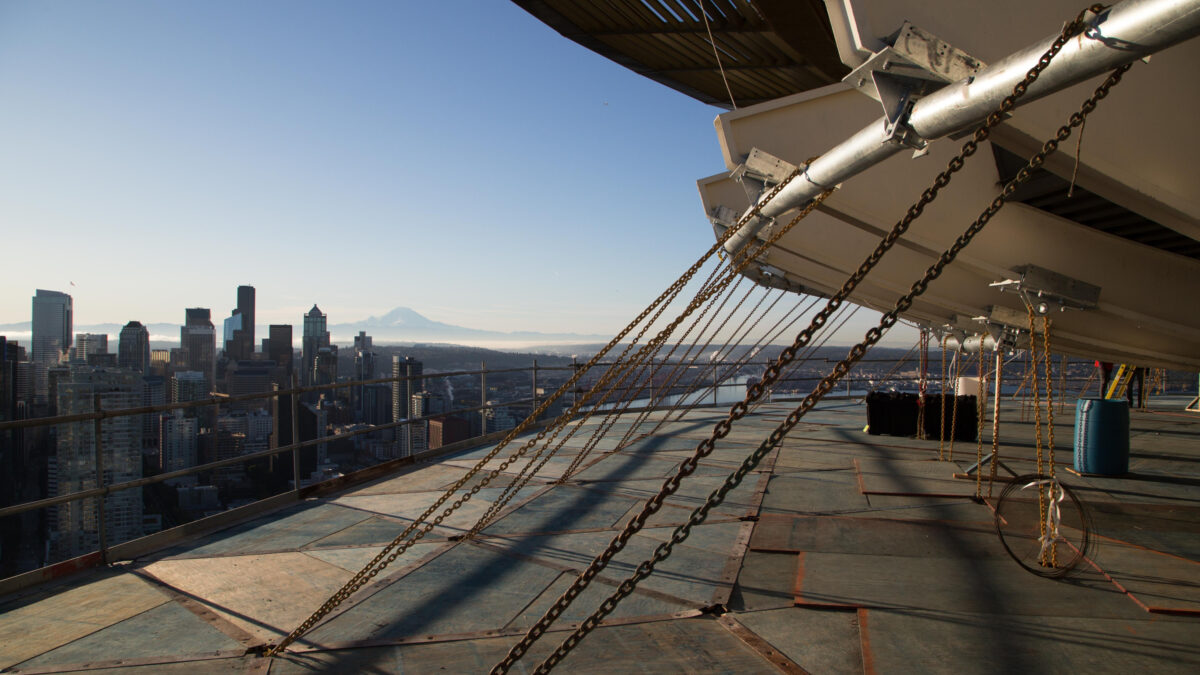About the Renovation


As one of the most recognized landmarks in the world, the Space Needle’s remodel focused on the preservation and renovation of the 1962 icon.
The renovation updated the structure’s physical systems and elevated the visitor experience by dramatically enhancing the view. Privately funded, the ambitious project heightened the observation deck experience with floor-to-ceiling glass on the interior and exterior to further open up the uninhibited 360-degree views of the Puget Sound. The 500-foot level was reimagined with a first-of-its-kind rotating glass floor revealing never-seen-before downward views of the structure.

In 2022, the American Institute of Architects (AIA) honored the visionaries of the project, Olson Kundig, with the National Architecture Honor Award. See press release for more information about this prestigious award.
In the conceptual designs from 1961-62, the observation windows were exaggerated in comparison to the Space Needle we know today. Building construction was limited to what the technology of the day would allow. The Century Project leverages cutting-edge glass technology to expand views and deliver the grand vision of the Space Needle’s founders.
Internal enhancement concepting was first presented to Seattle’s Landmarks Preservation Board in 2009. The project team started planning in 2013 and went back to the Landmarks Preservation Board in 2015 and 2016.
The project team worked with Seattle’s Landmarks Preservation Board, local architecture historians, original designers, preservationists and the community to be consistent with the original design intent and respect the character-defining features of the Space Needle. The team spent years working on the renovation plan for this significant structure to enliven the original designers’ bold aspirations into a new reinvigorated experience.
Through the innovative usage of materials and upgrades to internal systems the Century Project aims to achieve LEED Gold Certification, a significant feat for a building this unique.
Construction for phase one fully began in September 2017 and wrapped up in Summer 2018.
Pre-work included seismic work along the steel legs of the superstructure.
The Space Needle was built to withstand the largest earthquakes on record in 1962. Seismic tests today underscore its stability. Enhancements simply brought the building up to modern design standards.
Subsequent phases of the project will include the full completion of the updating the elevators, as well as repainting the structure.
THE 520-FOOT LEVEL FEATURING SKYRISERS
New glass barriers, which tilt outward to match the angle of the building, replaced the wire “caging” on the outer observation deck offering seamless sight lines.
Sleek, canted glass benches called Skyrisers are affixed to alternating glass barriers. The Skyrisers will leave guests – although inward facing – with feet dangling, leaning out over the city below for a perfect, spine-tingling Seattle selfie.
Floor-to-ceiling glass replaced the low-level interior walls on the observation deck, creating an uninhibited view from the moment guests step off the elevator.
In the original design, there were three doors opening to the outer observation deck. These areas have now doubled in size, allowing for a more open ingress and egress to the outer deck. A new, custom-designed, state-of-the-art accessibility lift will also be added.
In the interior, the Oculus Stairs – a dramatic new open circular stairway made of steel, wood, and glass – winds down from the observation deck to the 500-foot level. At the base of the new open stairway there is a glass-floored oculus revealing views of the Space Needle’s steel superstructure, as well as the elevators and counterweights ascending and descending.
The two half-moon staircases, for the first time ever, openly connect the upper 520-foot level to the lower 500-foot level. Expanded restrooms were also added on the 510-foot mezzanine level to better serve guest needs.
THE 500-FOOT LEVEL, FEATURING THE LOUPE
The Loupe, located on the 500-foot level, also features floor-to-ceiling glass and the world’s first and only revolving glass floor. Guests will now enjoy walking out onto awe-inspiring views of the city below and beyond.
Through the glass floor, guests are able to see the mechanics of the turntable, which consist of a series of 12 motors. The power transmission relies on rolling peg gears to minimize friction and wear.
The Space Needle continues to work with world-renowned hospitality designer Adam Tihany of Tihany Design to create a new food and beverage experience which will showcase the thrilling views. Stay tuned for details about the future of dining here at the Space Needle.
Materials and Process
The Century Project is innovative in its usage of glass, using virtually every variety available today. In total, 10 different types and more than 176 tons of glass have been used.
Most of the glass panels lack a mullion (or frame) between to allow for clean sight lines, again hearkening back to the original intention of the Space Needle – to observe the changing city below.
Already a complicated project due to the nature of construction over 500 feet in the air, the over-sized glass panels were hoisted with a gantry crane. Most other materials came up the Space Needle’s existing elevators.
An additional challenge during the project was the building itself. The Space Needle is an active building – contracting, twisting and expanding depending on wind and temperature – that would make any construction project and choice of materials a difficult one.
Hoffman Construction used cutting-edge technologies to scan the building for shop drawings. These virtual scans, which were conducted with a laser that is proven to be accurate within a 1/16 of an inch, are what informed the precise measurements for each of the hundreds of glass panels.
In order to remain open to the public, the construction team hoisted a temporary work platform 500 feet in the air using 12 independent cables and motors. Workers used the platform – weighing 100 tons and fixed to the canoe beams just below the 500-foot level – to install the glass floor and make other significant updates to the tower.
Outside of the glass, which was supplied by companies in Switzerland, Germany, and California, costs and partners were primarily Seattle or Pacific Northwest-based.